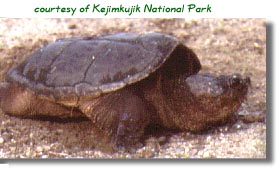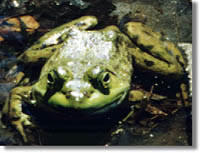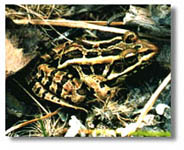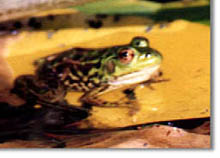Blandings Turtle (Emydoidea blandingi)
 The
shell of the Blandings turtle tends to be spotted or streaked with greyish yellow, and has
a high domed shape that resembles an army helmet. The plastron or bottom part of the shell
is yellow with symmetrically arranged black patches. Their head and neck are yellow on the
underside. Their plastron is hinged, which allows them to completely close their shell in
the back. They also have a long neck that can be retracted into the shell inside a fold of
skin.
The
shell of the Blandings turtle tends to be spotted or streaked with greyish yellow, and has
a high domed shape that resembles an army helmet. The plastron or bottom part of the shell
is yellow with symmetrically arranged black patches. Their head and neck are yellow on the
underside. Their plastron is hinged, which allows them to completely close their shell in
the back. They also have a long neck that can be retracted into the shell inside a fold of
skin.
Currently, the only population of Blandings turtles that exists in Canada is found in
and around the area of Kejimkujik National Park. The population is believed to be between
100 and 180 turtles. They favour plant-filled lakes, bogs, marshes, and coves, where they
can be found sunbathing on the banks.
Females will lay eggs between June and July, laying approximately eight 4 cm eggs which will hatch between August and September.
Kejimkujik Park has taken steps to ensure the protection and growth in population of this
turtle and it has been listed as threatened since 1973. A recent joint study between Acadia University and the park, lead to a greater
understanding of this species. They observed 22 juvenile turtles and
fitted some with radio transmitters, allowing them to track the turtles and learn even more
about their habits.
which will hatch between August and September.
Kejimkujik Park has taken steps to ensure the protection and growth in population of this
turtle and it has been listed as threatened since 1973. A recent joint study between Acadia University and the park, lead to a greater
understanding of this species. They observed 22 juvenile turtles and
fitted some with radio transmitters, allowing them to track the turtles and learn even more
about their habits.
Eastern Painted Turtle (Chrysemys pivcta picta)

These
colourful little turtles are the most common turtles in Nova Scotia. Their carapace (back or upper shell surface) is
green with a yellow center stripe and visible shell plates, which are yellow at the edges.
The outer edge of the shell is marked with red, while the plastron is a bright yellow. The
head is streaked with yellow and the neck, tail, and legs, are all streaked with red.
These turtles are very common in both Digby and Annapolis counties (southwestern
Nova Scotia), however, they are becoming less common or absent in other areas of the province. They
can be found in and around small ponds, lakes, and streams and can often be seen sunning
themselves on a rock or log. Their diet consists of snails, insects, and some plant matter.
Male Painted turtles reach sexual maturity at 2 to 5 years and females at 4 to 8 years. They
nest in sand or gravel areas then the young surface from the nest in the fall. There are
usually 5 to 20 soft-shelled eggs per nest and the young are approximately 2 cm to 3 cm in
diameter with a life span of 25 years.
Snapping Turtle (Chelydra serpentina serpentina)
 The
Snapping turtle is Nova Scotia's largest freshwater turtle, with a shell length of up to
35 cm. They look as if they have outgrown their shell, have thick powerful legs, and a
long tail. The carapace (upper shell surface) is a greenish-grey or dark green color with a jagged back end. The plastron (or breastplate) of the shell is noticeably smaller than
the carapace and this prevents the Snapping turtle from being able to draw up into it's
shell for protection.
The
Snapping turtle is Nova Scotia's largest freshwater turtle, with a shell length of up to
35 cm. They look as if they have outgrown their shell, have thick powerful legs, and a
long tail. The carapace (upper shell surface) is a greenish-grey or dark green color with a jagged back end. The plastron (or breastplate) of the shell is noticeably smaller than
the carapace and this prevents the Snapping turtle from being able to draw up into it's
shell for protection.
This inability to hide in its shell, and its slow speed, makes the Snapping turtle very
aggressive on land. They will attack by thrusting forward with their long neck and can
leave a painful bite. However aggressive they may be on land, they are equally as shy in
the water and will quickly swim away to avoid humans and they rarely leave the water.
Snapping turtles frequent shallow lakes and streams, in areas rich with plant life. They
eat fish, amphibians, and other creatures, both large and small located with their keen
sense of smell. They hibernate during the winter along the bottom of the river in the mud.
Atlantic Leatherback Turtle (Dermochelys coriacea coriacea)
Easily recognized by its smooth skinned shell (carapace), which has seven distinct
longitudinal keels, the Atlantic Leatherback is the largest living turtle in the world.
They are often over 1.5 meters in size and weigh over 800 kg. Their carapace varies
from black to brown with the flippers being black with white patches. The plastron
(ventral side of the shell) is white with black blotches.
They have a specially adapted throat with backward-pointing spikes to assist them in feeding exclusively on jellyfish. Females nest on sand beaches in equatorial
regions usually from April till November. They are regularly sited in Nova Scotia's waters
in late summer and fall and can be found anywhere along Nova Scotia's coast.
Atlantic Leatherbacks are endangered, and great
care must be taken to protect and preserve these large but timid creatures, as is the case with all marine turtles. Many die from
ingesting plastics which they mistake for jelly fish, others are drowned when caught
in fishing gear. At the Center for Wildlife and Conservation Biology at Acadia University
in Wolfville, efforts are being made to better understand the Leatherback turtle and their
life cycle. If you see a leatherback in Nova Scotia, please call 1-888-729-4667 and report
the location. If possible, please take pictures of the head region, as turtles may be
identified by distinctive head pigmentation. By better understanding these creatures, we
hope to protect them in the future.
Bullfrog
The Bullfrog is the largest frog found in the Maritimes. The young range in size from
4 cm to 5.5 cm while adult bullfrogs range from about 10 cm to about 14 cm. They are
yellow-green to green in colour. They are found in the greatest numbers in the lower half of the
province. They are the last amphibians to emerge in spring and they have a short season as
they are hibernating in the muddy lake bottoms by early September. Their loud call can be
heard from the middle of June to July. Females lay their eggs in a large film or jelly-like mass on the surface among the water lilies. They may produce up to 20,000 eggs with
the tadpoles taking two years to mature and develop their hind legs. Their diet consists
of frogs, fish, and insects.
greatest numbers in the lower half of the
province. They are the last amphibians to emerge in spring and they have a short season as
they are hibernating in the muddy lake bottoms by early September. Their loud call can be
heard from the middle of June to July. Females lay their eggs in a large film or jelly-like mass on the surface among the water lilies. They may produce up to 20,000 eggs with
the tadpoles taking two years to mature and develop their hind legs. Their diet consists
of frogs, fish, and insects.
Green Frog
Green frogs closely resemble bullfrogs, however they are much smaller, and have a more
varied colour. They may be yellow to green to a bronze colour. They range in size from
3 cm to 4 cm for the young and from 7 cm to 11 cm for adults. The easiest way to tell a green frog
from a bullfrog is the ridge which green frogs have running from behind each eye, part way
down their back. Mating takes place in June and July with the female producing about 1,500
to 5,000 eggs. These eggs will float on the surface in a jelly-like membrane. The green
frog takes one year to reach maturity. The tadpoles will develop into frogs during the winter at the bottom of a river under silt or decaying plant matter. Their diet consists of a variety of insects, snails, and even spring peepers.
Pickerel Frog
 The Pickerel frog is found throughout Nova Scotia and closely resembles the
Leopard frog. Pickerel frogs have rows of irregular rectangular brown spots on their back.
These spots usually number between 7 and 20. They are yellow-brown with an underside that
changes to an orange colour as the frogs age. They range in size from 2.5 cm to 3 cm for
the young and 5 cm to 8 cm for the adults. They tend to be found in vegetated aquatic
environments. Hibernating during the winter, they emerge in the spring, and mating season
lasts throughout May. The females will produce approximately 1,000 eggs and, while the eggs are encased
in the same jelly-like substance as those of other frogs, Pickerel frogs attach the mass to plants
about 10 cm below the surface. For this reason, Pickerel eggs are rarely seen. Tadpoles
reach maturity by August or early September of the same year. Their diet consists mainly
of insects.
The Pickerel frog is found throughout Nova Scotia and closely resembles the
Leopard frog. Pickerel frogs have rows of irregular rectangular brown spots on their back.
These spots usually number between 7 and 20. They are yellow-brown with an underside that
changes to an orange colour as the frogs age. They range in size from 2.5 cm to 3 cm for
the young and 5 cm to 8 cm for the adults. They tend to be found in vegetated aquatic
environments. Hibernating during the winter, they emerge in the spring, and mating season
lasts throughout May. The females will produce approximately 1,000 eggs and, while the eggs are encased
in the same jelly-like substance as those of other frogs, Pickerel frogs attach the mass to plants
about 10 cm below the surface. For this reason, Pickerel eggs are rarely seen. Tadpoles
reach maturity by August or early September of the same year. Their diet consists mainly
of insects.
Northern Leopard Frog
Where Pickerel frogs have rectangular spots in rows on their backs, the Northern Leopard
frog has haphazardly located oval spots. They have two prominent dorsolateral folds that run the length of their back with two to four smaller folds
between these. The young range from 2.5 cm to 3 cm in length with adult frogs 5.5 cm to 10 cm
in length. The mating period is from mid-April to mid-May with the females producing
roughly 3,000 eggs in an oval shaped mass in shallow water. They can be found throughout
Nova Scotia in fields, meadows, and grassy roadside ditches. They eat mainly insects. They play an important role in keeping agricultural
pest populations down because they dwell in grassy areas.
dorsolateral folds that run the length of their back with two to four smaller folds
between these. The young range from 2.5 cm to 3 cm in length with adult frogs 5.5 cm to 10 cm
in length. The mating period is from mid-April to mid-May with the females producing
roughly 3,000 eggs in an oval shaped mass in shallow water. They can be found throughout
Nova Scotia in fields, meadows, and grassy roadside ditches. They eat mainly insects. They play an important role in keeping agricultural
pest populations down because they dwell in grassy areas.
Northern Spring Peeper
The Northern Spring Peeper is grey to brown in colour with a dark strip down the sides
of its head and dark markings on its back. Peepers are generally heard and not seen. They
are an average size of only 2 cm to 4 cm when fully grown. Their high pitched "peep-peep-peep" can fill the night air in the spring. They awake from hibernating in March,
and will leave their woodland hibernation sites for grassy ditches and the marshy edges of
ponds. Females produce about 1,000 eggs that they lay individually on twigs and plant
material found at the bottom of ponds. The tadpoles mature quickly and are fully developed
by September. After the mating season is over, adult frogs head back to their woodland
environment for the summer and will hibernate there for the winter too. Their diet consists
mainly of small spiders and insect larvae. Due to the fragile nature of these creatures,
the health of their populations is used as a guide in determining the health of the
environment. Groups such as the Nova Scotia Frog Watch help monitor the health and numbers of
these small but boisterous creatures.



